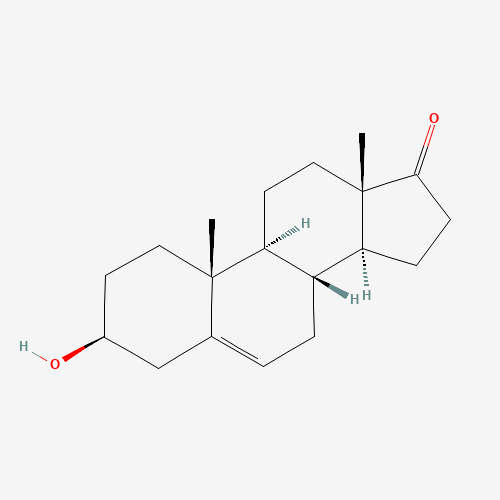| Pharmaceutical Information |
| Drug Name |
Prasterone |
| Drug ID |
BADD_D02446 |
| Description |
Prasterone, also known as dehydroepiandrosterone (DHEA) is a major C19 steroid produced by the adrenal cortex. It is also produced in small quantities in the testis and the ovary. Dehydroepiandrosterone (DHEA) can be converted to testosterone; androstenedione; estradiol; and estrone. Most of DHEA is sulfated (dehydroepiandrosterone sulfate) before secretion.
In the United States, DHEA or DHEAS have been advertised with claims that they may be beneficial for a wide variety of ailments. DHEA and DHEAS are readily available in the United States, where they are marketed as over-the-counter dietary supplements. In November 2016, DHEA was approved (as Intrarosa) to treat women experiencing moderate to severe pain during sexual intercourse (dyspareunia), a symptom of vulvar and vaginal atrophy (VVA), due to menopause.
In Canada, a prescription is required to buy DHEA. |
| Indications and Usage |
DHEA is taken as a supplement for a variety of unsubstantiated indications. The following indications have shown promise and are backed up by some scientific evidence: schizophrenia (DHEA may be more effective in women than men); improving the appearance of older people’s skin (taking DHEA by mouth seems to increase skin thickness and moisture, and decrease facial “age spots” in elderly men and women); improving ability to achieve an erection in men with sexual dysfunction. Additionally, DHEA has shown promise in improving symptoms of lupus (SLE). Taking DHEA by mouth along with conventional treatment may help reduce the number of times symptoms flare up and may allow a reduction in the dose of prescription drugs needed. DHEA may also help SLE symptoms such as muscle ache and mouth ulcers. DHEA also seems to strengthen bones in SLE patients being treated with high-dose steroids (corticosteroids).
DHEA also shows promise in the treatment of osteoporosis. Taking DHEA by mouth daily seems to improve bone mineral density (BMD) in older women and men with osteoporosis or osteopenia (pre-osteoporosis). DHEA may also increase BMD in young women with the eating disorder called anorexia nervosa. DHEA is often prescribed in India for the induction of ovulation to improve chances of pregnancy. |
| Marketing Status |
approved; investigational; nutraceutical |
| ATC Code |
A14AA07; G03XX01 |
| DrugBank ID |
DB01708
|
| KEGG ID |
D08409
|
| MeSH ID |
D003687
|
| PubChem ID |
5881
|
| TTD Drug ID |
D0K0EK
|
| NDC Product Code |
51927-2960; 76420-688; 72495-401; 72495-501; 75882-422; 63776-653; 64025-0017; 76420-689 |
| UNII |
459AG36T1B
|
| Synonyms |
Dehydroepiandrosterone | 5-Androsten-3-beta-hydroxy-17-one | 5 Androsten 3 beta hydroxy 17 one | DHEA | Prasterone | Androstenolone | Dehydroisoandrosterone | Prasterone, 3 alpha-Isomer | Prasterone, 3 alpha Isomer | 5-Androsten-3-ol-17-one | 5 Androsten 3 ol 17 one |
|
| Chemical Information |
| Molecular Formula |
C19H28O2 |
| CAS Registry Number |
53-43-0 |
| SMILES |
CC12CCC3C(C1CCC2=O)CC=C4C3(CCC(C4)O)C |
| Chemical Structure |

|
|
| ADRs Induced by Drug |
|
|
*The priority for ADR severity classification is based on FAERS assessment, followed by the most severe level in CTCAE rating. If neither is available, it will be displayed as 'Not available'.
**The 'Not Available' level is hidden by default and can be restored by clicking on the legend twice..
|
|
| ADR Term |
ADReCS ID |
ADR Frequency (FAERS)
|
ADR Severity Grade (FAERS)
|
ADR Severity Grade (CTCAE)
|
|
|
|

